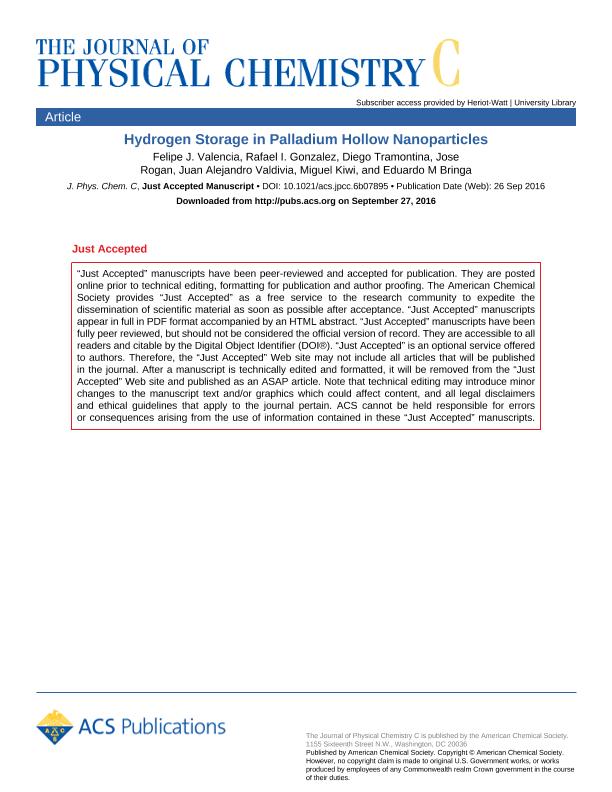Artículo
Hydrogen Storage in Palladium Hollow Nanoparticles
Valencia, Felipe J.; González, Rafael I.; Tramontina Videla, Diego Ramiro ; Rogan, José; Valdivia, Juan Alejandro; Kiwi, Miguel; Bringa, Eduardo Marcial
; Rogan, José; Valdivia, Juan Alejandro; Kiwi, Miguel; Bringa, Eduardo Marcial
 ; Rogan, José; Valdivia, Juan Alejandro; Kiwi, Miguel; Bringa, Eduardo Marcial
; Rogan, José; Valdivia, Juan Alejandro; Kiwi, Miguel; Bringa, Eduardo Marcial
Fecha de publicación:
10/2016
Editorial:
American Chemical Society
Revista:
Journal of Physical Chemistry C
ISSN:
1932-7447
Idioma:
Inglés
Tipo de recurso:
Artículo publicado
Clasificación temática:
Resumen
The potential and properties of palladium hollow nanoparticles (hNPs) as a possible H storage material are explored by means of classical molecular dynamics (MD) simulations. First, we study the stability of pure Pd hNPs for different sizes and thicknesses, obtaining good agreement with experimental results for nanometer size Pd hNP. Next we add, every 100 fs, single H atoms into the NP cavity. During the first stages of the simulation, our results show hydride formation on the inner surface, similar to what has been observed in experiments on Pd surfaces and NPs. Formation of the Pd hydride decreases the absorption rate, and H gas is formed inside the cavity. The maximum H gas pressure that is reached is of 7 GPa, before fractures appear in the hNP, and consequently the hNP breaks up. We obtain a maximum H/Pd ratio of 1.21 when H is introduced only inside the cavity. However, when H is deposited both on the inside and outside surfaces, this ratio reaches 1.70, which is 25% larger than previous reports. Beyond this ratio, the hNP breaks up, and the H gas is ejected from the hNP cavity.
Palabras clave:
Palladium
,
Nanoparticles
,
Hidrogen Storage
,
Molecular Dynamics
Archivos asociados
Licencia
Identificadores
Colecciones
Articulos(CCT - MENDOZA)
Articulos de CTRO.CIENTIFICO TECNOL.CONICET - MENDOZA
Articulos de CTRO.CIENTIFICO TECNOL.CONICET - MENDOZA
Citación
Valencia, Felipe J.; González, Rafael I.; Tramontina Videla, Diego Ramiro; Rogan, José; Valdivia, Juan Alejandro; et al.; Hydrogen Storage in Palladium Hollow Nanoparticles; American Chemical Society; Journal of Physical Chemistry C; 120; 41; 10-2016; 23836-23841
Compartir
Altmétricas



